| |
|
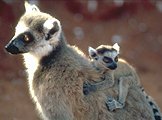 |
|
Ring-tailed lemurs |
|
The
order
Primates
 includes humans, apes, monkeys, and prosimians. Many of them may be familiar, but it would not be surprising if you cannot
immediately visualize prosimians (like the ring-tailed lemurs in the picture on the
right).
includes humans, apes, monkeys, and prosimians. Many of them may be familiar, but it would not be surprising if you cannot
immediately visualize prosimians (like the ring-tailed lemurs in the picture on the
right).
How many living primate
species exist today is not
clear. The number varies depending on whether closely related
groups are considered to be varieties
of each other or distinct species. Some
taxonomic splitters classify up
to 350 species,
while lumpers include as few as 190. Most estimates are in the range
of 230-270. This ambiguity may be partly resolved in the future with DNA sequencing data.
Compounding the problem is the fact that every few years new
species of primates are found.
The tropical forests of South America, Africa, and Southeast Asia may still be hiding
ones that are unknown to the scientific world.
However, it is likely that all major groupings of primates have been
discovered.
Many primate
species are now in danger of
becoming extinct. The primary cause is deforestation, driven ultimately by human
population growth. Additional pressure is placed on
primate populations by humans hunting them to sell for food and pets.
Monkeys and apes are popular sources of "bush meat" in West Africa.
At least 22 species of primates and many other kinds of wild animals are being hunted
in Africa for this purpose. Despite the fact that the sale of "bush
meat" is outlawed in most countries, it is now being sold illegally in
Europe and North America. In recent years, it could be bought at stores that cater to
African immigrants in Paris, New York, Chicago, San Francisco, Montreal, and
some other major cities.
Today, non-human
primates are limited in their natural habitats primarily to the tropical and subtropical
regions of the New and Old Worlds.
They have never lived in Australia and most of the islands in the Pacific
ocean. However, the earliest primates also lived in North America and
Europe beginning around 55-50 million years ago.
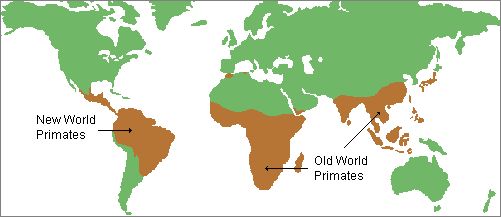 |
| Natural range of non-human
primates |
General Characteristics
of Primates
| |
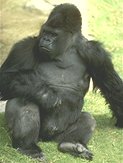 |
| Lowland gorilla |
Primates are
surprisingly variable in size. They range all the way from the
pygmy mouse lemur that
weighs less than 2 ounces (55 g.) and can fit in the palm of your
hand to the gorilla that grows to as much as 440 pounds
(200 kg.) in the wild
and even heavier in captivity. Still larger primates existed in the past but are now
extinct.
Primates are
generally lively, clever, and very successful at adapting to different environmental
opportunities. Physically, however, they are relatively unspecialized compared to
animals such as birds, horses, and cats. Primates are not particularly
fast runners, they do not have the sharpest hearing, they cannot fly, nor
are they efficient hunters.
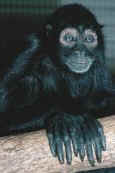 |
|
| Spider monkey
Count the number of
fingers...
(This is the only primate that
has hands
with 4 fingers and
feet with 5 toes) |
|
With the exception
of spider monkeys, all of the primates have retained the ancient mammalian trait of
pentadactylism
 , which is having five fingers on each hand and five
toes on each foot. An increasing refinement of the hands and
feet for grasping objects has been a hallmark of primate evolution. Their fingers
and toes are mobile and have very sensitive tactile pads at the tips, unlike most
other mammals. At least some digits on all primates also have flat nails in
place of rigid claws. This makes the manipulation of bits of food and other objects
much easier.
, which is having five fingers on each hand and five
toes on each foot. An increasing refinement of the hands and
feet for grasping objects has been a hallmark of primate evolution. Their fingers
and toes are mobile and have very sensitive tactile pads at the tips, unlike most
other mammals. At least some digits on all primates also have flat nails in
place of rigid claws. This makes the manipulation of bits of food and other objects
much easier.
The grasping, or prehensile
 , ability of
primate hands varies significantly also with
the degree of opposability of the thumb. Partially rotating the thumb and pressing
it forcefully towards the fingers provides a secure grip for hanging on branches and for
manipulating small objects. All primates, with the exception of humans, have
prehensile feet in addition to hands. However, few have the high degree of thumb
opposability and strength typical of humans.
, ability of
primate hands varies significantly also with
the degree of opposability of the thumb. Partially rotating the thumb and pressing
it forcefully towards the fingers provides a secure grip for hanging on branches and for
manipulating small objects. All primates, with the exception of humans, have
prehensile feet in addition to hands. However, few have the high degree of thumb
opposability and strength typical of humans.
The
small New World monkeys called marmosets and tamarins usually hang onto a tree
branch by pressing against it with their palms and using all of their bent fingers
together as counter pressure in a hook-like power grip.
The more dexterous
monkeys and apes can also use a secure power grip formed by the
partial flexion of the fingers and the palm with counter force applied by the thumb.
Humans and
some apes also can employ precision grips formed by pinching with the tips of their
flexed forefingers and the thumb. This allows their hands to be used effectively for
manipulating small objects, such
as the fork in the hand of the chimpanzee shown below.
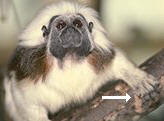 |
|
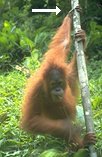 |
|
 |
|
Hook-like power grip
(cotton-top tamarin) |
Precision grip
(chimpanzees) |
| |
Secure power
grip
(orangutan) |
|
| |

|
Upright posture
(lowland gorilla) |
All primates
have a marked tendency towards erectness in their upper bodies. This can be seen in
their sitting and standing postures as well as occasional bipedalism
 .
They also have shoulder joints that are unusually flexible for mammals. This is due
to secure ball joints and strong
clavicles
.
They also have shoulder joints that are unusually flexible for mammals. This is due
to secure ball joints and strong
clavicles
 , or
collarbones, which have allowed them to use their arms very effectively
in climbing trees. Clavicles are another ancient
mammalian trait that primates have retained.
, or
collarbones, which have allowed them to use their arms very effectively
in climbing trees. Clavicles are another ancient
mammalian trait that primates have retained.
In primate
evolution, there was a progressive reduction in nose size and in the olfactory
 areas of
the brain. Lemurs are an
exception. They are very much like the early primates
50 million years ago. Note
the marked difference between lemur, monkey, and human noses in the photos
below. Most
monkeys and apes have evolved relatively small noses like us,
while lemurs have retained long snouts similar to foxes and
raccoons.
It is not surprising that lemurs have a comparatively good sense of smell.
areas of
the brain. Lemurs are an
exception. They are very much like the early primates
50 million years ago. Note
the marked difference between lemur, monkey, and human noses in the photos
below. Most
monkeys and apes have evolved relatively small noses like us,
while lemurs have retained long snouts similar to foxes and
raccoons.
It is not surprising that lemurs have a comparatively good sense of smell.


 |
|
Comparison of
ring-tailed lemur,
patas monkey, and human noses |
Most mammals have about the same number of genes that
code for odor receptors in their nasal tracks. However, the majority
of these genes in humans, and presumably other large primates, are no longer
functional. Recent research has shown that of the approximately 1,000
human olfactory receptor genes, only 347 remain functional. The rest
have mutations that deactivate them. Does this
really mean that people have a
poor sense of smell? The answer is both yes and no. We are poor
at sensing short-chain chemical compounds but good at discriminating between
complex long-chain ones such as those of many foods and flowers. Dogs
are just the opposite in this. However, the smelling ability of dogs
is far superior to people in one way. Fewer molecules of a substance
are usually needed for dogs to detect it.
As the
primate nose progressively shrank in size over millions of
years, there was a corresponding increase in
visual capabilities. As much as 50% of the
cerebral cortex in some species
of monkeys is involved in visual processing. Many primates have color vision comparable to our own.
All have binocular vision with fields
of view that significantly overlap, resulting in true
three dimensional
(3-D) depth
perception or stereoscopic vision. At the same time,
the field of view for peripheral
vision was reduced.
|
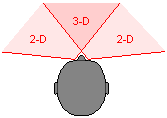
(view from above) |
|
Human
eyes have an overlapping field of view
of about 120. It is only in this field that we
have
stereoscopic vision.
Beyond this 3-D
area out to 160-180, we see
things only in
two dimensions (2-D)--i.e., flat
without depth.
Monkeys and apes have about the same
depth perception ability as humans, but the
eyes of lemurs are farther apart resulting in a
smaller overlapping field of view. |
|
|
|
|
Depth perception is an
invaluable tool for animals that need to move quickly. It allows them to judge
the distances to important objects in their environment. For monkeys
jumping from branch to branch high up in the canopies of forests, this is a
matter of life and death. Likewise, accurate depth perception is a
critical capability for hunters, such as cats and hawks, who need to
accurately judge distances in the pursuit
of their prey. In contrast, it is often preferable to have greater
peripheral vision if you are the prey. Gazelles, rabbits, and chickens
have nearly a 360 field of view, but relatively little of that is
stereoscopic vision.
Compared to
most other animals, primate brains are large relative to their body size. Those
areas of the brain that are involved with controlling manual dexterity, eye-hand coordination, and
stereoscopic vision have particularly
expanded. These traits were probably selected by nature mostly due to their
usefulness in traveling in trees, manipulating objects,
and getting food.
|
Primate Gestation Periods
(measured in days) |
|
ring-tailed lemur |
135 |
|
baboon |
164-186 |
|
chimpanzee |
216-260 |
|
orangutan |
240-270 |
|
human |
266 |
|
gorilla |
270 |
|
|
|
|
| |
|
Primate Life Spans in the Wild
(measured in years) |
| mouse
lemur |
about
8 |
|
ringtail lemur |
11+ |
|
vervet monkey |
15-20 |
|
baboon |
30 |
|
chimpanzee |
30-50 |
|
gorilla |
25-30 |
|
| |
Note:
primates in modern zoos often
live longer than the life spans listed
here because of the medical care
that they receive. |
The more capable uterus
and placenta of primates support long gestation periods,
or pregnancies, for
animals of their size. For example, the mouse lemur
has a gestation period of 60 days, but it is only 20 days for a comparable
size rodent mouse.
Macaques,
which are one of the most common groups of monkey species in the Old World,
have 13.5-15.5 week gestations. Among comparable size domesticated
dogs, it is only about 9 weeks. The result of long
gestations is that offspring are born more mature and,
therefore, have a greater chance of survival. Primate mothers also are generally
very protective and nurturing with their young. Subsequently, primates do not need
to have many offspring to maintain their population numbers. Multiple births at any
one time are rare for them.
The time gap between
generations is surprisingly long for the larger primates. Among humans
today, parents are on average 29 years older than their children. By
comparison, chimpanzee mothers are on average 25 years older than their
offspring. Among female gorillas, it is 19.3 years.
There frequently
is a correlation between body size and longevity in the animal kingdom.
Species with larger bodies generally live longer. However, primates
have unusually long natural life spans for
their size. For instance, mouse
lemurs live about 8 years. Rodent mice
rarely reach 2 years. Rats, which are slightly larger than mouse
lemurs, can live 3 years. Big monkeys, such as baboons, live up to 30
years. Male baboons can weigh as much as 90 pounds.
Comparable size domesticated dogs have a life expectancy of only 10-12
years. With
good medical care, chimpanzees can live nearly as long as people
(50-75+ years). This is not surprising
given that they are anatomically very similar to us. Research done
by Herman Pontzer of Hunter College suggests that the unusual longevity of
primates is due to the fact that they expend only 50% as many calories a day
compared to other animals their size. Slower metabolism rates are
associated with slower rates of growth, reproduction, and aging in mammals.
Most
primates have adapted to an arboreal, or tree living, way of life. Even the terrestrial
 ones usually sleep in the
trees. The most notable exceptions are humans
and gorillas. Both of these species live on the
ground with occasional tree climbing for fun, especially
by children. Almost all primates are diurnal, which is to say, they are active
during the day and sleep at night.
ones usually sleep in the
trees. The most notable exceptions are humans
and gorillas. Both of these species live on the
ground with occasional tree climbing for fun, especially
by children. Almost all primates are diurnal, which is to say, they are active
during the day and sleep at night.
Generally,
primates are highly social animals. Most of their waking hours are spent socializing
with each other. This is made easier by complex vocalizations and
visual displays. In addition, they regularly groom
each other, thereby keeping clean and satisfying psychological needs
at the same time.
Grooming is
a very pleasurable activity for primates, including humans. It is important to note that the few nocturnal
 primate species are the least social.
primate species are the least social.
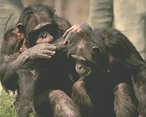 |
|
 |
| Chimpanzees
grooming |
Humans grooming |
Primates
have been very successful animals due largely to the fact that they are intelligent and
opportunistic in getting food. Most are unusually adaptable in diet. This has
tremendous evolutionarily selective value. Many species are omnivorous
 , though vegetable foods usually make up the
bulk of calories consumed by most primate species because they are easier to obtain.
By comparison, animals such as koalas and giant pandas are generally less
successful because they are extremely limited in the kinds of foods that they
can or will eat. Koalas subsist on the leaves of a few species of
eucalyptus, and giant pandas primarily eat the shoots of a small number of
bamboo species. If these food sources are not available, koalas and
giant pandas die. Not surprisingly, their highly limited range of foods
restricts where they can live. This is not the case with many primate
species.
, though vegetable foods usually make up the
bulk of calories consumed by most primate species because they are easier to obtain.
By comparison, animals such as koalas and giant pandas are generally less
successful because they are extremely limited in the kinds of foods that they
can or will eat. Koalas subsist on the leaves of a few species of
eucalyptus, and giant pandas primarily eat the shoots of a small number of
bamboo species. If these food sources are not available, koalas and
giant pandas die. Not surprisingly, their highly limited range of foods
restricts where they can live. This is not the case with many primate
species.
Are Primates Good
Pets?
Often people who have not had the responsibility of
taking care of a monkey or ape in captivity think that they would be great
pets. After all, they are cute when they are youngsters and remarkably
human-like. However, they generally make very poor pets. As one
monkey owner said "People find out when it's too late. After six
months, they're like a two year-old that can fly." Because they are
intelligent, very active, sometimes unpredictable, and easily bored, they
frequently get into trouble when left alone. In addition to being
destructive, most are as messy as human babies. Unlike humans,
however, they remain this way all of their unusually long lives.
Owning large apes in particular is a lifelong commitment that takes
considerable patience, energy, and money. Male
chimpanzees can be surprisingly violent in their interactions with
each other and humans. In recent years, several people have been
extensively maimed and even killed by their pet chimpanzees in the U.S.

![]() includes humans, apes, monkeys, and prosimians. Many of them may be familiar, but it would not be surprising if you cannot
immediately visualize prosimians (like the ring-tailed lemurs in the picture on the
right).
includes humans, apes, monkeys, and prosimians. Many of them may be familiar, but it would not be surprising if you cannot
immediately visualize prosimians (like the ring-tailed lemurs in the picture on the
right).











